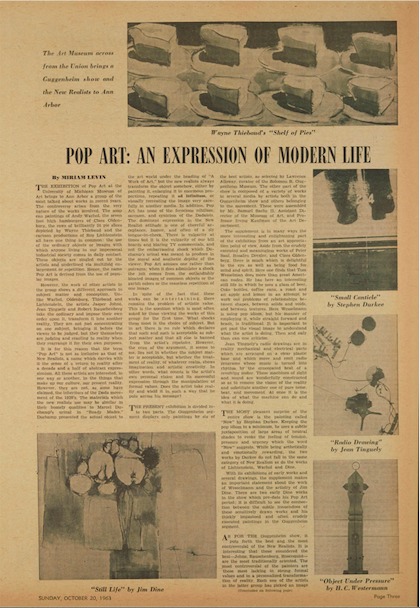Response
Reviews and Reactions at the University of Michigan
Reactions of museum attendees recorded in local and regional papers ranged from sophisticated art criticism to visceral distaste for the art. A reader of the Ann Arbor News critiqued the exhibitions in a letter to the editor, challenging “whether such works of anti-art belong in a museum at all...One goes to the museum to see something for which one can have some respect. Instead, the current exhibition’s oversized, poorly painted vulgarity leaves one with the urge to deface it...” (Crawford 1963). A puzzled student, assigned to cover the exhibition for The Michigan Journalist , responded to such criticism by quoting Henry Geldzahler, an assistant curator of the Metropolitan Museum of Art, “Pop art is immediately contemporary. We have not yet assimilated to its new visual content and style. I think the point is...to admit the possibility that the subject matter and techniques are and can be the legitimate subject matter and technique of art.” The Journalist also reminds readers that “in any artistic period some of the works are worthwhile and some are trash; with time, the worthless is forgotten while the real art remains...It must be understood that trash is often necessary to help stimulate the real thing” (Chase 1963). More lighthearted responses included a woman stating that the paintings “remind [her] of the A&P,” a supermarket company, and a young girl pointing out that “noodle’s spelled wrong” in a Warhol painting.
Museum goers also responded to the noise produced by Tinguely’s Radio Drawings, an uncommon addition in an art museum even today. One commented, hands over her ears, “If you had a bad day, your nerves would frizzle” (Lind et al, 1963). By mid-October, the curator and Assistant Director Samuel Sachs wrote to a colleague that the two exhibitions “Have met with an unprecedented response here . . . We are daily breaking our attendance records.” (Sachs to Allan Frumkin, 1963).
- Kate Johnson, RZ



